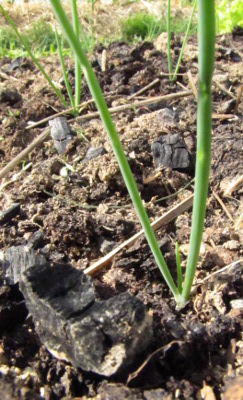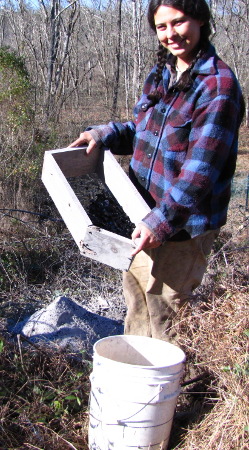
Biochar a dud in temperate regions
 Do you remember the biochar
craze from a few years ago? Everyone from Mother Earth News to the Extension
Service was touting charcoal's benefits as a soil amendment, and if you're like us you
probably tried it in your own garden.
Do you remember the biochar
craze from a few years ago? Everyone from Mother Earth News to the Extension
Service was touting charcoal's benefits as a soil amendment, and if you're like us you
probably tried it in your own garden.
After a few trials, my
conclusion was that biochar didn't provide any visible benefit to our
soil beyond a very slight warming effect for extremely early spring
crops. And, to my
surprise, science now backs that assertion up. A
comparison of over a thousand biochar studies concluded that biochar
has no discernable benefit in temperate regions (although it does help a lot in tropical soils
where high heat and rainfall mean that organic matter decomposes and
nutrients leach away in short order).
 So
will I stop sifting charcoal
out of my wood ashes
to apply to the garden? Probably not. Like any other source of organic
matter, biochar improves soil texture over the long run, and processing
the waste from our wood stove only takes about half an hour per year.
So
will I stop sifting charcoal
out of my wood ashes
to apply to the garden? Probably not. Like any other source of organic
matter, biochar improves soil texture over the long run, and processing
the waste from our wood stove only takes about half an hour per year.
But I'm glad I didn't burn wood specifically for the purpose of
creating biochar. After all, hugelkultur builds soil fertility even
more and is a good fit for already punky wood. So bury that wood
instead of burning it if you want to boost your soil the best!
Want more in-depth information? Browse through our books.
Or explore more posts by date or by subject.
About us: Anna Hess and Mark Hamilton spent over a decade living self-sufficiently in the mountains of Virginia before moving north to start over from scratch in the foothills of Ohio. They've experimented with permaculture, no-till gardening, trailersteading, home-based microbusinesses and much more, writing about their adventures in both blogs and books.
Want to be notified when new comments are posted on this page? Click on the RSS button after you add a comment to subscribe to the comment feed, or simply check the box beside "email replies to me" while writing your comment.
- Remove comment
- Remove comment
- Remove comment
